A flat white is not just a small latte. They are very different drinks. If you’re caught in a cafe that doesn’t serve a flat white, then a small latte might be a passable substitute, but they’re not the same drink. The flat white vs latte debate is common in the UK and USA where the Flat White is still new.

I drink flat whites and my girlfriend drinks lattes so I’ve seen the difference between the two drinks in cafes across England, France, Spain, Denmark, USA, New Zealand and Australia. I’ve had a lot of discussions with baristas and it’s time to shine some light on the common debate about “What is a flat white?”
How can a small latte, a flat white and a small cappuccino all use the same shot of espresso and be served in the same cup but still be different drinks?
How much coffee is there in your coffee?
We can hold the preparation of the espresso as a constant. You can have a double shot or a single shot in a flat white or in a latte. Some people would say that a single shot flat white isn’t really a flat white, but that’s a bit too purist and there are plenty of cafes in New Zealand and Australia that do serve singles.
It’s not the size of the cup, it’s what you do with it
In most cafes, a flat white is smaller than a latte. But that doesn’t mean that a flat white is a small latte. It’s a bit like saying that a shed is just a smaller house. Sure, most sheds are smaller than most houses, but size isn’t the decisive factor. If a barista has been un-trained (or over-trained) then they may think that size is the only difference between a flat white and a latte. I like asking those baristas what the difference is between a cappuccino vs a latte because they have to fall back on the real differences (beyond just size).
Milk is the forgotten ingredient in a latte
If we hold the espresso as a constant, then what makes a flat white versus a latte or a flat white versus a cappuccino is the milk. Milk is the hidden ingredient in a modern coffee. Most people forget how important milk is to a good coffee. When milk is frothed with a steam wand there are three layers that form:
- Heated liquid milk at the bottom of the pitcher
- Velvet microfoam in the middle of the pitcher (these are very small bubbles)
- Stiff froth (these are larger bubbles)
The important process of “stretching” the milk by frothing, folding and swirling it is done to maximise the amount of velvet microfoam by blending the large bubbles and the liquid milk. Without swirling and tapping there would still have some microfoam but you’d never know it in the cup because it would be lost in the liquid and/or the froth.

The art of frothing milk is to keep the steam wand at the surface of the milk (that pleasing steamy sound you hear in busy cafes). Most baristas learn to froth milk pretty fast because it’s obvious when it works or doesn’t. The main differences between drinks and between baristas arise when the steaming is finished and it’s time to pour the drink. – A good barista will swirl the steamed milk around to fold the froth back into the liquid and create a seamless pitcher of velvet microfoam. Some might tap the pitcher on the counter to pop the worst of the big bubbles on top (as part of folding the milk). But this is unnecessary if you’re swirling the milk smoothly enough.
Crema
Crema is the orange caramelised coffee that floats to the top of an espresso. It tastes sweeter than the dark coffee part but it’s very vulnerable and can be destroyed by sitting too long or being drowned in milk. A cappuccino sacrifices the crema under the weight of the stiff froth and a latte can kill the crema with milk. One of the main ways of telling if you have been served a good flat white is how much of the milk has merged with the crema to form an even dusky orange swirl. This coloration of the milk is the starting point of latte art.
How to make a flat white different to a latte
An excellent barista can “free pour” straight from the pitcher using speed of the pour and the tilt of the jug to choose how much froth, foam or liquid to pour into any given drink. A mid-level barista is more likely to do it like this:
- Cappuccino: spoon the stiff froth into the cup and then top up with a pour from the jug.
- Latte: Pour the liquid milk from the jug with a spoon to hold back the froth and then top off with a dollop of froth.
- Flat white: Free pour for a mix of froth and liquid.
Like any human endeavour, there is a bell curve to the skills of baristas. The most ignorant of baristas will make a flat white, latte or a cappuccino all the same. After all, they’re just a “milky coffee”. Ironically, some very high end baristas have the same attitude because they take so much care with frothing, folding and pouring their milk that every coffee is made like a perfect flat white with an even mix of liquid, microfoam and froth.

The net effect of this variety of approaches to the milk is that the drinks will feel different in the mouth and may taste different because of the dilution of the coffee with liquid. In terms of mood and mouthfeel:
- Cappuccino has stiff foam and feels like drinking bubbles with a bed of coffee hidden at the bottom.
- Latte is milky, has a little foam on the top and feels like drinking a milky coffee.
- Flat White has an even mix of liquid milk and smooth velvet foam so it feels like drinking an espresso, only yummier.
The best way to test the flat white vs latte would seem to be to go to a small independent cafe and order a cappuccino, a latte and a flat white. But the goal of ordering a coffee isn’t really to compare a static reality, it’s to express to the barista your intention and desires. So order based on what you’d enjoy: a frothy treat, a milky warm sensation or a short sharp shot of coffee that goes down easy.













